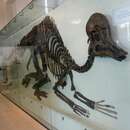en
names in breadcrumbs


Corythosaurus is a genus in Hadrosauridae, one of the “duck-billed” dinosaurs. It lived in the Late Cretaceous, approximately 76.5 to 74.8 million years ago. It was herbivorous, with dental batteries packed with hundreds of teeth to process tough fibrous plant material. With a tall domed crest, Corythosaurus is one of the most recognizable of hadrosaur dinosaurs. It was a large dinosaur, reaching lengths of 8-10 m and weighing close to 2800 kg (1). Corythosaurus is abundant in fossil deposits in North America and a wide range of skeletons has been found, from juveniles to adults. “Mummified” specimens have been discovered as well, with detailed skin impressions and articulated bones still joined together in the same position as they were when the animal was alive (2).
Corythosaurus lived in the Late Cretaceous, approximately 76.5 to 74.8 million years ago. Like all other “duck-billed” hadrosaurs, it was an herbivore. Specimens from this genus are commonly found in Dinosaur Park in Alberta, Canada (1). When Corythosaurus was alive, this habitat was a forested floodplain with coastal wetlands and cool winters (1).
This environment was characterized by abundant diversity among dinosaurs, plants, and other animal species. Other dinosaurs found here include ceratopsids such as Centrosaurus and Styracosaurus, ankylosaurs, dromeosaurs, pachycephalosaurs, and large theropod dinosaurs like Gorgosaurus and Daspletosaurus. Other animal groups are well represented as well. Crocodilians, turtles, lizards, and small early mammals have also been discovered at Dinosaur Park. Plant fossils include gingko, conifers, and ferns. Massive bonebeds have been found containing many dinosaur individuals. Paleontologists have interpreted this as the result of periodic droughts, which caused mass dinosaur mortality (2).
Two species are currently recognized in the Corythosaurus genus, Corythosaurus casuarius and Corythosaurus intermedius. Originally, there were seven species sharing this genus. Five of these species were later recognized to be different growth stages or genders of the remaining two (1). The taxonomic identity of C. intermedius is the matter of some debate as well, with some paleontologists contending that it may be the female form of C. casuarius (2).
Corythosaurus is a member of Hadrosauridae, the group that contains the “duck-billed” dinosaurs such as Edmontosaurus, Parasaurolophus, and Maiasaurua. Within Hadrosauridae, Corythosaurus is further classified in the smaller group Lambeosaurinae. The two Corythosaurus species are closely related, and other close relatives include Hypacrosaurus and Arenysaurus (3).
The most distinctive feature of Corythosaurus is the high domed crest atop its skull. Initially, paleontologists speculated whether crests in Corythosaurus and other “duck-billed” hadrosaur dinosaurs might function as a snorkel when the animal was submerged in water. This is now understood to be pure speculation. In reality, the crest most likely functioned in auditory and visual display. The crest shows signs of sexual dimorphism in Corythosaurus, with males and females displaying different sizes and shapes. The crest first began to develop at approximately half adult size. This indicates that the crest probably played some role in sexual selection among mature individuals (1). The nasal passage of Corythosaurus traveled through the crest, so air would be passed through the crest during breathing. The inner structure of the crest was complicated, with side pockets and chambers. This structure could have produced very low resonant sounds. Adults produced low trumpeting sounds, while juveniles with less developed crests had higher-pitched calls (1).
Corythosaurus had teeth similar to other “duck-billed” hadrosaur dinosaurs. The front of its snout was toothless, covered by a beak. Teeth were restricted to the sides of the skull, packed close together in massive dental batteries. Of these teeth, approximately 270 might be in use at any given time. For each tooth currently in use, 2-4 replacement teeth waited in reserve below it. Unlike humans, Corythosaurus underwent continuous tooth replacement throughout life. Individual teeth were slender and small, but strengthened by close packing (1).
Species related to Corythosaurus have been discovered with fossilized stomach contents containing fruits, seeds, conifer needles, and twigs. It is likely that Corythosaurus had a similar diet. By studying features of the skull, paleontologists have determined that Corythosaurus was able to chew with a unique range of fore, aft, and lateral motions. While chewing, they could have held plant material in muscular cheeks. Corythosaurus was able to process its food very efficiently, as may have been necessary for a diet of fibrous plants with low nutritional value (1).